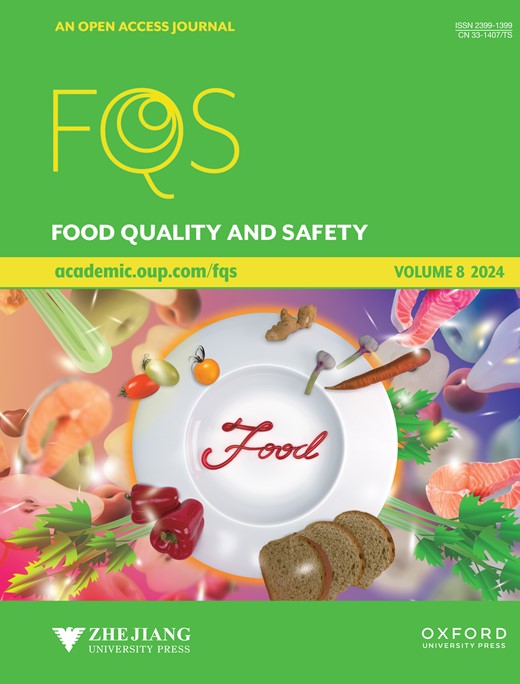从油籽中提取油脂的关键步骤是减少杂环芳香胺
IF 4.4
3区 农林科学
Q2 FOOD SCIENCE & TECHNOLOGY
引用次数: 0
摘要
摘要杂环芳香胺(HAAs)对植物油的污染是植物油生产中存在的风险之一,食用油生产企业一直在努力降低其在最终产品中的含量。本研究对亚麻籽、花生、菜籽油、芝麻、葵花籽等5种油脂进行了两种预处理(烘烤和微波)、四种提取(两种压榨和两种溶剂萃取)和吸附精制(四种吸附剂)工艺条件的研究。结果表明,微波预处理产生的HAAs明显少于焙烧(p < 0.05)。经过两次预处理,各油脂的HAA含量由高到低依次为:葵花籽油、芝麻油、亚麻籽油、菜籽油、花生油。溶剂萃取油(9.16 ~ 316.73µg/kg)的HAAs含量低于压榨油(26.61 ~ 633.93µg/kg)。使用吸附剂后,油中HAAs的去除率由21.77 ~ 484.22µg/kg降至0.31 ~ 41.58µg/kg,去除率达到99.28%。该研究为石油生产过程中获得安全的最终产品提供了关键的HAA减少策略。本文章由计算机程序翻译,如有差异,请以英文原文为准。
Critical steps in the production of oil from oilseed to reduce heterocyclic aromatic amines
Abstract Contamination by the heterocyclic aromatic amines (HAAs) norharman and harman is one of the risks in vegetable oil production, so oil producers strive to decrease their content in the end products. In this study, the effects of production conditions—specifically, two pretreatment methods (roasting and microwaving), four extraction methods (two pressing and two solvent extraction) and adsorption refining (four absorbents)—of five oils (flaxseed, peanut, rapeseed, sesame, and sunflower seed) were evaluated. The results showed that microwaving as a pretreatment produced significantly fewer HAAs than roasting (P<0.05). After two pretreatments, the HAA content of oils was ranked from high to low as follows: sunflower oil, sesame oil, flaxseed oil, rapeseed oil, and peanut oil. Solvent-extracted oils (9.16–316.73 µg/kg) had fewer HAAs than pressed oils (26.61–633.93 µg/kg). Using adsorbents reduced HAAs in oils from the initial 21.77–484.22 to 0.31–41.58 µg/kg, and the removal rate reached 99.28%. This study provides critical HAA reduction strategies for application in the oil production process to obtain safe final products.
求助全文
通过发布文献求助,成功后即可免费获取论文全文。
去求助
来源期刊

Food Quality and Safety
FOOD SCIENCE & TECHNOLOGY-
CiteScore
7.20
自引率
1.80%
发文量
31
审稿时长
5 weeks
期刊介绍:
Food quality and safety are the main targets of investigation in food production. Therefore, reliable paths to detect, identify, quantify, characterize and monitor quality and safety issues occurring in food are of great interest.
Food Quality and Safety is an open access, international, peer-reviewed journal providing a platform to highlight emerging and innovative science and technology in the agro-food field, publishing up-to-date research in the areas of food quality and safety, food nutrition and human health. It promotes food and health equity which will consequently promote public health and combat diseases.
The journal is an effective channel of communication between food scientists, nutritionists, public health professionals, food producers, food marketers, policy makers, governmental and non-governmental agencies, and others concerned with the food safety, nutrition and public health dimensions.
The journal accepts original research articles, review papers, technical reports, case studies, conference reports, and book reviews articles.
 求助内容:
求助内容: 应助结果提醒方式:
应助结果提醒方式:


